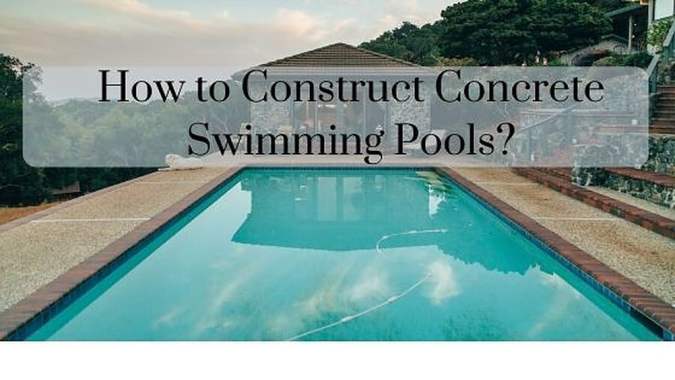Building a concrete swimming pool involves proper planning, excavation, formwork installation, steel reinforcement positioning, pouring concrete, and finishing with tiling or plaster. It requires careful consideration of the pool’s design, size, and location, as well as adherence to local building codes and regulations.
The construction process involves various steps, including excavating the site, constructing a formwork to shape the pool, placing steel reinforcement for strength, and pouring concrete into the formwork. Once the concrete has cured, the pool can be finished with tiling or plaster.
Proper construction techniques and professional guidance are essential for building a durable and long-lasting concrete swimming pool.
Choosing The Perfect Location For Your Pool
When choosing the perfect location for your concrete swimming pool, there are several factors to consider. One important factor is evaluating the site’s sun exposure. You want to ensure that your pool receives adequate sunlight throughout the day to keep the water warm and inviting.
Additionally, considering the landscaping options is crucial. The surrounding landscape should complement the pool design and enhance its overall aesthetic appeal. It’s important to assess the existing vegetation, trees, and any potential obstacles that may interfere with the pool installation or maintenance.
By carefully considering these factors, you can select the ideal location for your concrete swimming pool that maximizes enjoyment and functionality.
Obtaining The Required Permits And Licenses
To build a concrete swimming pool, it is crucial to obtain the necessary permits and licenses. This involves researching the local regulations and ensuring that all the required approvals are obtained. To simplify the process, it is recommended to hire a professional who can assist with obtaining the permits.
They will have the expertise and knowledge to navigate the complicated permitting process. By following these steps, you can ensure that your concrete swimming pool is built in compliance with all the legal requirements and regulations.
Excavation And Preparing The Site
Excavation is the first step in building a concrete swimming pool. Hiring an excavation contractor ensures a smooth process. Clearing the designated area and marking out the pool dimensions are crucial tasks. Inactive voice: “The designated area is cleared, and the pool dimensions are marked.
” By following these steps, you can prepare the site for the next stages of pool construction. Bear in mind the importance of a well-executed excavation to ensure a sturdy and stable pool foundation. Expert excavators will have the knowledge and tools required to complete this phase efficiently and effectively.
With the site prepared, you can proceed with confidence to the next stage of your swimming pool project.
Setting Up The Formwork And Reinforcement
Constructing the formwork for a concrete swimming pool involves using either plywood or metal panels. These materials provide the necessary support and structure for the pool’s shape. Next, it is essential to install steel reinforcement within the formwork. The steel reinforcement adds structural strength to the pool, ensuring its longevity and durability.
By following these steps, you can create a solid foundation for your concrete swimming pool. Once the formwork and reinforcement have been completed, you can move on to pouring the concrete and finishing the pool. Building a concrete swimming pool requires careful planning and execution to achieve a beautiful and long-lasting result.
Pouring And Leveling The Concrete
To build a concrete swimming pool, it is crucial to pour and level the concrete correctly. Before starting this process, preparing the concrete mixture is essential. Once the mixture is ready, begin by pouring it onto the excavation area. Spread the concrete evenly using a screed board or a long piece of wood.
Make sure to fill all the edges and corners properly. After pouring, use a bull float to smooth the surface and remove any excess water. Continue leveling the concrete by using a hand float and a trowel, making sure it is flat and consistent.
It is essential to work quickly while pouring and leveling the concrete to prevent it from drying unevenly.
Curing And Waterproofing The Concrete
Curing and waterproofing are crucial steps when building a concrete swimming pool. Allowing the concrete to cure properly ensures it gains strength and stability. This is achieved by maintaining the right temperature and humidity levels. Applying a waterproofing membrane is equally important to prevent leaks and water damage.
This is done by carefully coating the entire surface of the concrete with a specialized waterproofing product. The membrane acts as a protective barrier, preventing water from seeping into the pool structure. It is important to ensure thorough coverage, paying attention to corners, edges, and any potential weak points.
By following these steps, you can ensure that your concrete swimming pool is durable, long-lasting, and free from any leaks or structural issues.
Finishing Touches: Tiles, Coping, And Decking
Building a concrete swimming pool involves various finishing touches like selecting and installing tiles for the pool interior. Carefully choose tiles that are durable, water-resistant, and provide a pleasing aesthetic. Next, focus on installing coping stones, which will edge the pool and create a smooth transition from the pool to the surrounding decking.
Coping stones should be securely placed to ensure long-lasting stability. Lastly, consider the pool deck, which can be made from various materials such as concrete, pavers, or wood. The deck should provide a comfortable and safe area for poolside activities.
Remember to plan the layout of the tiles, coping stones, and decking to ensure a seamless and visually pleasing pool area. With attention to these finishing touches, you can create a beautiful and functional concrete swimming pool.

Credit: www.bobvila.com
Filling And Maintaining Your Concrete Pool
Building a concrete swimming pool requires proper filling and maintenance. To start, fill the pool with water, ensuring it reaches the desired level. Once filled, it’s crucial to balance the chemical levels. Regularly monitor and adjust the pH and chlorine levels to maintain a clean and safe swimming environment.
Additionally, keep the pool clean by regularly vacuuming the bottom and skimming the surface to remove debris. A pool cover can help minimize the amount of dirt and leaves that enter the water. Regularly check the pool equipment, including the pump and filter, to ensure they are functioning properly.
By following these guidelines, you can enjoy a well-maintained concrete pool for years to come.
Frequently Asked Questions For How To Build A Concrete Swimming Pool?
What Are The Pros And Cons Of Building A Concrete Swimming Pool?
Concrete swimming pools offer durability and customization options, but they require significant upfront investment and ongoing maintenance.
How Long Does It Take To Build A Concrete Swimming Pool?
The construction time of a concrete swimming pool can vary depending on factors like size and complexity, but it generally takes around 8 to 12 weeks to complete.
What Is The Average Cost Of Building A Concrete Swimming Pool?
The cost of building a concrete swimming pool can range from $50,000 to $100,000 or more, depending on various factors such as size, design, location, and additional features.
Conclusion
Building a concrete swimming pool requires careful planning, proper materials, and skilled labor. By following the steps outlined in this blog post, you can successfully construct a stunning pool that will provide enjoyment for years to come. Start by determining the location, size, and shape of your pool.
Prepare the site by excavating the area and ensuring a level base. Install the pool plumbing and electrical systems before pouring the concrete. Once the concrete has been poured and set, apply a waterproofing sealer to protect the pool from water damage.
Remember to consider safety features such as fencing, lighting, and non-slip surfaces. In addition, regular maintenance is crucial to keep the pool clean and functioning properly. By staying proactive with cleaning, chemical balancing, and equipment maintenance, you can extend the life of your pool.
Building a concrete swimming pool can be a challenging endeavor, but with the right knowledge and preparation, you can achieve the ultimate backyard oasis. From start to finish, this guide has provided the essential steps to help you create the pool of your dreams.
So go ahead and dive into the process of building your own concrete swimming pool!

















